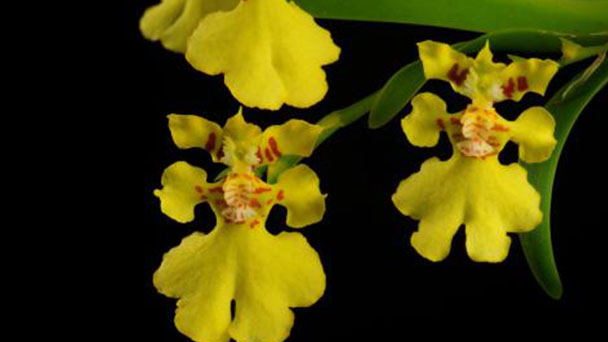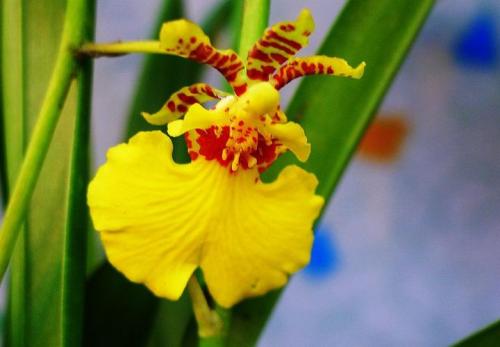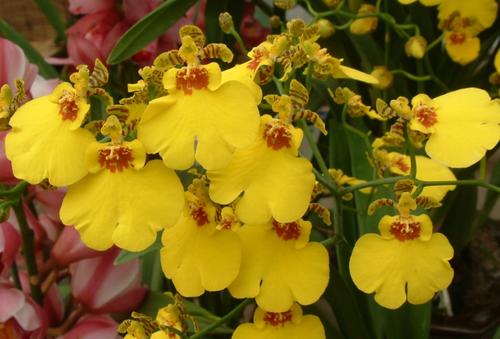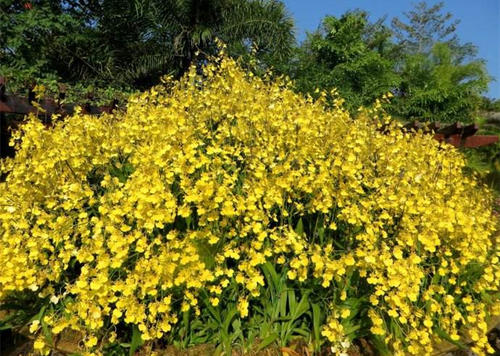Orchid hybrid profile
Written by Maggie
Jan 20 2021

Orchid hybrid, scientific name Oncidium hybridum is light, natural and unrestrained, the flower stem is light and drooping, the flowers are strange and lovely, the shape is like a flying king butterfly, very dynamic, is one of the world's important potted flowers and cut flowers.
Orchid hybrid picture

Orchid hybrid characteristics
Orchid Hybrid is a multi stemmed aerial Orchid with oval, spindle, round or oblate pseudo rbulm. Pseudo Corms are nutrient storage and supply organs. They grow with nutrient growth and shrink with reproductive development. Around February, the new buds start from the base of the original pseudocoelom and gradually form a new pseudoform. Anatomical observation showed that the newly formed vegetative bud contained 13 to 14 segments, among which the pseudocorm formed below the first segment. After pseudo corn maturation, the primary basal axillary buds differentiated into flower stems, which grew rapidly after July and bloomed in mid-October. Orchid Hybrid has 1-3 leaves, and can be divided into thin leaf species, thick leaf species and sword leaf species.
Orchid Hybrid has a unique flower type and high ornamental value. Flowers are pure yellow, magenta, pink, or with tan patterns, spots, inflorescences are more variable, there are one or two upright open, ten, hundreds, and so on. The inflorescence is well branched, beautiful flower shape, bright color, close to the shape of the Chinese character "auspicious". At the same time blooming flowers in the breeze blowing just like a group of dress dancing girls, its hand, head, waist, body, skirt image lifelike. Orchid Hybrid is the new favorite of foreign orchids, its natural and unrestrained free from vulgar flower posture and gentle and elegant revelation, by the flower arrangement circle as cut flower "five beauties" one.
Some Orchid hybrids have only one or two flowers on a stem, while some have hundreds of flowers. For example, a small flower used as a cut flower has dozens of flowers on a single stem and hundreds or hundreds of flowers on several branches. Some are as small as the Orchid Hybrid, while others are as large as the Orchid Hybrid. The diameter of the flowers can reach more than 12cm. The structure of the flower is very special. The calyx and sepals are equal in size, and the petals and dorsal calyx are almost equal or slightly larger. The lip of the flower usually trifid, or large or small, was fiddle-like, in the base of the lobe has a ridge-like protuberance, ridge and protuberant small spots, quite peculiar, hence the name of the tumor petal orchid.
Orchid Hybrid Growth Habits
The temperature conditions
The Orchid Hybrid is originally made in the US, Mexico, Guyana and Peru.Orchid Hybrid prefers warm and hot environments, while Orchid Hybrid prefers cold and cool climate for thin (or soft) and sword-leaf types. The optimum temperature for the growth of Orchid Hybrid with thick leaves is 18 ~ 25℃, and the temperature in winter is no less than 12℃. The optimum temperature for the growth of thin-leaf type is 10-22 ℃, and the temperature in winter is not lower than 8℃.
Like humid and semi-cloudy environment
Orchid Hybrid likes a humid and semi-shady environment. Apart from watering to increase the substrate humidity, Orchid Hybrid is more important to spray water on the leaf surface and ground. Increasing the air humidity is more beneficial to the growth of leaves and flower stems. Hard leaf varieties have strong drought resistance and dry death did not occur in winter without watering for a long time.
Endurance is strong
Phenomenon, its endurance is very strong. Sunshade net is needed for large-scale production, with shading rate of 40% ~ 50% being suitable. Winter needs sufficient sunshine, generally does not need a sunshade net, beneficial to flowering.
Orchid Hybrid is native to the tropical regions of the Americas. The most widely distributed Orchid Hybrid is found in Brazil, the United States, Colombia, Ecuador and Peru.
Distribution climatic conditions: but its distribution area is wide, tropical, warm zone, high mountain temperate zone and cold zone.
Orchid Hybrid's ecological habits
The Orchid Hybrid is originally made in the US, Mexico, Guyana and Peru. The Orchid Hybrid prefers warm and hot conditions, while the Orchid Hybrid prefers thin or soft leaves and sword-leaf hybrids. Orchid Hybrid likes cold and cool climates. The optimum temperature for Orchid Hybrid with thick leaves was 18 ~25℃, winter temperature is not lower than 12 °C. The optimum temperature for the growth of thin-leaf type is 10-22 ℃, and the temperature in winter is not lower than 8℃.
Orchid Hybrid likes a humid and semi-shady environment. Apart from watering to increase the substrate humidity, Orchid Hybrid is more important to spray water on the leaf surface and ground. Increasing the air humidity is more beneficial to the growth of leaves and flower stems.Hard leaf varieties have strong drought resistance, long winter without watering did not dry dead phenomenon, its strong endurance. Sunshade net is needed for large-scale production, with shading rate of 40% ~ 50% being suitable. Winter needs sufficient sunshine, generally do not need a sunshade net, beneficial to flowering.
Cultivated in pot or planter beds with fern roots, mosses, ash, bark blocks, etc. Thin-leaved species have thin leaves.

Growing method sof Orchid Hybrid
Place
Orchid Hybrid with thick leaves can be cultivated extensively, while Orchid Hybrid with thin leaves should have a greenhouse for heat preservation in winter besides Orchid shed.
Plant
Orchid Hybrid uses potted plants for most varieties.The pot planting material is similar to that used in phalaenopsis cultivation.Such as water moss, snake sawdust, charcoal, perlite, broken brick, peat soil and so on. The combination of these planting materials works well. When planting, the bottom 1/3 of the pot should be padded with gravel or broken brick to facilitate ventilation and drainage. The flowerpot of cultivation can use plastic basin, element burn basin, porcelain basin to wait. Orchid Hybrid cultivated for more than 2 ~ 3 years will grow up gradually and grow small plants. The root system is too full, so we should change the pot in time. Planting is usually carried out after flowering. For non-flowering plants, it can be carried out before the growth period, such as when the weather becomes cool in early spring and autumn. Cultivation materials should be replaced together, and planting can be carried out together with planting.
Light
The Orchid Hybrid is similar to the Catlan, shading 50% to 60% of the sun in summer and 20% to 30% in winter. The sun is too strong, the growth is slow, the plant is short and causes sunburn disease, finally the leaf dries up, even the whole plant dies. If there is too much shade and insufficient light, the plant leaves will grow poorly, affecting the differentiation of flower buds and significantly reducing flowering, sometimes even not flowering.
The temperature
Generally, Orchid Hybrid with thick leaves likes warm, and the suitable temperature for growth is 18 ~ 25℃, and cold resistance should be required below 12℃. It is more suitable for cultivation in South China. Orchid Hybrid of thin leaf type likes cold and cold, and can not tolerate high temperature. Its growth temperature is 10 ~ 22℃, which is difficult to adapt to flat land. Therefore, Orchid Hybrid should be cultivated in cold and cool areas at middle altitude, but when cold waves come in winter, it will be put in the greenhouse for winter.
Moisture
Like most orchids, Orchid Hybrid likes higher air humidity. However, Orchid Hybrid has different plant types and resistance to drought. Varieties that do not have pseudobulbs are less resistant to drought, so keep the substrate in the basin moist and replenish it as soon as it dries. Reduce water in winter, conducive to flowering, the temperature at 10℃ to stop watering. Water should be sprayed on the ground, benches, roads and plants around the plants in hot summer to increase air humidity, otherwise it will affect their growth.
Fertilizer
First with a small amount of slow release fertilizer for the base fertilizer, every 2 ~ 3 weeks to apply 1500 ~ 2000 times the liquid water-soluble quick fertilizer, not flowering to apply nitrogen, phosphorus, potassium "three elements" balanced compound fertilizer, leaf spraying, can also be applied to the root. Phosphorus and potassium fertilizer should be added near flowering to promote flower bud differentiation and flowering.
Orchid Hybrid propagation methods
Orchid Hybrid is propagated by tissue culture and plant division. Orchid hybrid is an Orchid with multiple stems. When the Orchid plants grow into adults, they will grow seed plants. When the seed plants have pseudobulbs, they can be cut off from the mother plant. Propagation by dividing plants usually takes place after flowering or in spring and fall.
Orchid Hybrid is easy to cultivate for tissue culture. Generally, seeds, stem tips, flower ears and other vegetative organs are used for propagation. In seed culture, 3 grams of Huabao No. 1, 2 grams of tryptone and 35 grams of sugar were used to prepare the medium for seed germination.The addition of 15% coconut water can promote the germination of seeds. Orchid Hybrid had no Browning in shoot tip culture and flower ear culture. The most suitable medium for shoot tip and flower ear culture was 1/2MS, modified Knudsonc and V&W medium. Or seeding mediums can be, in principle, without hormone. The subculture of the original corn can be used in the same culture with 5% ~ 10% banana juice or 15% ~ 20% coconut juice added.Seedling culture can use the above medium or V&W medium.
Pest control of Orchid Hybrid
Orchid Hybrid are common pests such as snails, scale insects and whitefly. In the rainy season in spring and summer, snails are often active. At this time, lime powder should be regularly sprinkled around the orchard and around the planting frame. Orchid Hybrid is mainly infested with scale insects. Scale insects parasitic on the edge of plant leaves or leaf level surface suction juice caused plant wilt, serious plant will be yellow and die.It can be killed with 40% oxidized dimethoate emulsion 1000 times liquid spray or 50% marathon emulsion 2000 times liquid spray. White whitefly can be killed with 3000 times liquid speed by aphid or aphid. Agro Streptomycin can be sprayed in the morning or evening after the disease occurs. It is advisable to spray no more than 3 times in a year.
Disease control of Orchid Hybrid
The diseases of Orchid Hybrid mainly include soft rot and leaf spot. When leaf spot occurs, Orchid Hybrid will damage the leaves, and when soft rot occurs, the whole plant will die. It can be controlled with a 1000 times solution of 50% carbendazim and 800 times soluble wet agent of 50% tobutazin.
Orchid Hybrid main value
At present, Orchid Hybrid mainly produces and sells cut flowers, potted flowers and garden cultivation.
Orchid Hybrid is an extremely beautiful and ornamental Orchid. As one of the most important varieties of cut Orchid flowers in the world, Orchid Hybrid is suitable for home and office bottle holders. It is also a high-grade flower material for processing bouquets and small flower baskets. Orchid Hybrid is the Orchid Hybrid, which has a bright yellow color. Each flower is like a beautiful girl with a fluttering skirt and dancing in a pleasant mood. The flower is said to be happy and carefree, implying to forget worries and worries.

Latest Updated
- Benefits of Bugleweed - 7 Science-backed Health Benefits
- Bugleweed Dangers & Side Effects - Is It Poisonous?
- How to Plant Evergreen Trees - What You Should Know
- When to Plant Evergreens - Grow Guide for Evergreen Trees
- 12 Wonderful Evergreen Shrubs for Your Garden
- 12 Popular Evergreen Plants with Pictures for Beginners
- When And How To Prune A Lilac Bush Like a Pro
- How to Grow & Care for Lilac Vine (Hardenbergia Violacea)
- Japanese Lilac Tree (Syringa Reticulata) Care & Propagation Guide
- Shumard Oak Pros and Cons - What to Know
Popular Articles
- Winter maintenance of Antirrhinum Majus
- How to Grow Terminalia Mantaly Tree
- How to Grow and Care for Crossostephium Chinense
- How to grow Antirrhinum Majus in spring
- Peristeria Elata (Dove Orchid) Profile: Info & Care Guide
- Underwatered Snake Plant (Sansevieria Trifasciata) - Signs And How To Fix
- How to Care for Brazilian Jasmine Plant (Mandevilla Sanderi)
- How to Grow & Care for Graptopetalum Purple Delight in Summer
- Rosa Chinensis (China Rose): Plant Growing & Care Tips
- How to Care for Baby Sun Rose (Aptenia Cordifolia)